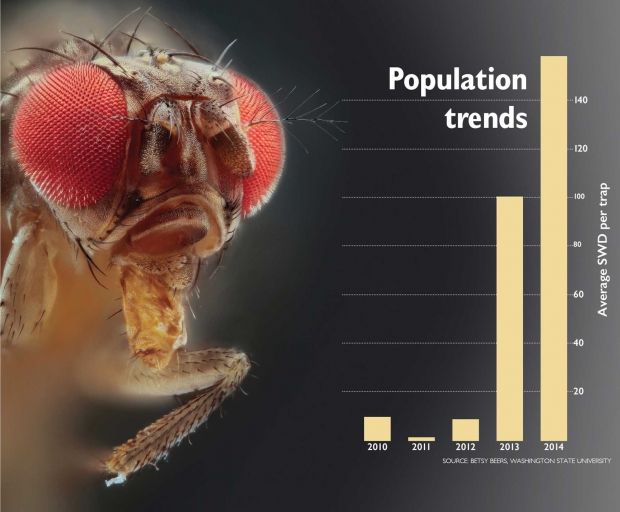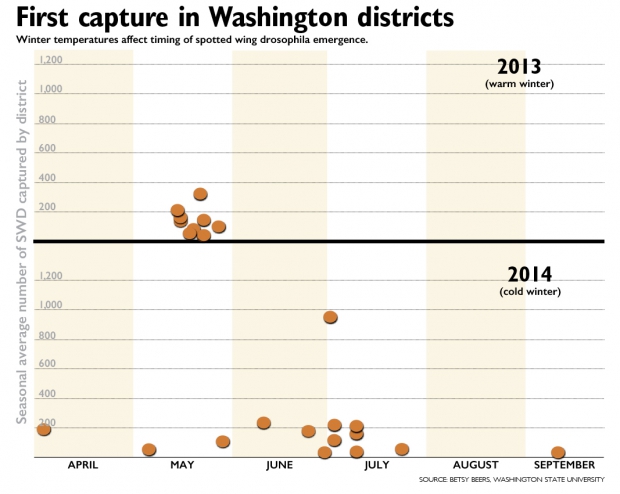
Spotted wing drosophila is showing greater establishment in eastern Washington in 2013 and 2014. (Spotted wing drosphila fly photo courtesy Dr. André De Kesel, illustration by Jared Johnson/Good Fruit Grower)
Now that many of the basic questions about spotted wing drosophila (SWD) have been answered, scientists can focus on bringing integrated pest management back to impacted crops like cherries.
When spotted wing drosophila showed up in the United States more than five years ago, little was known about the invasive fruit fly that was native to Asia. The pest, first detected in California in 2008, was found in western Washington and parts of Oregon in 2009, and by 2010, it was detected in eastern Washington, Michigan, and six other states.
The fruit industry had zero knowledge about the pest when it was first discovered, says Dr. Betsy Beers, Washington State University entomologist. “It’s been a five-year voyage of discovery, and we’ve gone from knowing essentially nothing about spotted wing drosophila to learning quite a bit about it.”
That voyage has been a collaborative, regional research effort for stone and small fruits funded through the federal Specialty Crops Research Initiative. A team of nearly 30 university and private industry scientists from Washington, Oregon, and California participated. Researchers in other parts of the country, including Michigan, have also contributed to research efforts.
Everywhere
An extensive network of traps that were placed throughout Washington during the last five years showed that spotted wing drosophila was “everywhere we looked for it,” Beers said. The peak number of traps in the state was almost 360 in 2013. Researchers focused their traps on cherries and blueberries in eastern Washington because those were the known high-risk crops, but traps were also placed in grapes, peaches and nectarines, apricots, caneberries, apples, and some feral plants (chokecherries, Himalayan blackberries).
“Trapping was important because we needed to know when and where spotted wing drosophila would show up and when sprays should be applied,” she said, summarizing five years of data during the annual meeting of the Washington State Horticultural Association. “Initially, our recommendation to cherry growers was to spray when the first fly was caught and fruit are susceptible.”
Spray recommendations based on a single fly detection have been necessary because researchers don’t have enough confidence in the trapping systems.
Spotted wing drosophila is unlike ordinary fruit fly species because females don’t need to wait for fruit to be damaged or over-ripe and can lay eggs in unripe fruit. “Cherries have to be dead green to not be susceptible,” said Beers. “They don’t like cherries as much at straw color, but they will lay eggs then (at least in the lab). Fruit are fully susceptible two weeks after straw color.”
Cherries are also vulnerable at straw color to damage from Western cherry fruit fly, she said, which means that timing for control of both species likely can be wrapped together.
Greater establishment
Five years of trapping data in eastern Washington showed that the seasonal phenology of the pest is remarkably consistent. “Population numbers are low from January through spring, and then in August, numbers begin to kick up. They go crazy in fall through November, if temperatures remain mild,” Beers said.
 Though abundance patterns have been consistent, researchers have noticed big year-to-year differences in the density of flies caught per trap. Strict comparisons between years cannot be made because trap design and locations have changed, but Beers said population trends show increasing numbers which reflect better establishment in Washington.
Though abundance patterns have been consistent, researchers have noticed big year-to-year differences in the density of flies caught per trap. Strict comparisons between years cannot be made because trap design and locations have changed, but Beers said population trends show increasing numbers which reflect better establishment in Washington.
“I believe the trend of better establishment is a real one,” she said. “We’re seeing seasonal variation. Population buildup in 2014 was later than 2013, and pest timing of the two years was different, but they were both big years in terms of numbers trapped.”
Beers believes winter temperatures affect spotted wing drosophila by inflicting higher levels of winter mortality, which delays population buildup. Cold winters with single digit temperatures, such as those in 2011 and 2014, shifted the timing when flies were first caught in most regions. “In 2011, things shifted dramatically, and most regions didn’t catch any flies until after the first of August, which is after peak cherry harvest,” she said. But during the 2012 season, which followed a mild winter, fly catches were spread throughout the season. In 2013, after a very warm winter, catches were also early, coming out in May.
“The 2013 season had a few flies caught during the winter, and then nearly every trap in the state lit up in mid-May,” she said. “It was a very high-pressure year for cherries because they were susceptible for essentially the entire season.”
But the seasonal variation in populations also presents opportunities for IPM controls, Beers said. Trapping design and baits have also evolved in the last five years. Effective traps are needed so growers know if spotted wing drosophila is in their orchard, and they can use them to time sprays.
Just about every style of container that holds liquids has been studied. Tests found that the Haviland trap (a food storage container trap designed by David Haviland, University of California extension advisor) performed best (probably because of its large bait surface area). Additionally, red and yellow were found to be the most attractive colors in a national study, although this varied by crop.
The real game changer in attracting spotted wing drosophila to traps was the development of synthetic lures. Two lures have been commercially developed by Trécé and Scentry, based on research from scientists at U.S. Department of Agriculture’s research station in Yakima, Washington. (See “The lure of a better fly trap,” Good Fruit Grower, May 15, 2014.)
“For the first time, we have synthetic lures as opposed to homemade concoctions, which means we now have product with quality control and some degree of reliability,” Beers said.
In comparing Trécé and Scentry lures with apple cider vinegar, which has been the standard for fruit fly baits, researchers found that although apple cider vinegar worked well late in the season, synthetic lures attracted more flies earlier.
Beers noted that for cherries, early in the season—in June and July— is when detection is important, not in October when fruit are long gone. “So if someone tells you their bait catches more flies, be sure to ask when, because trapping more flies in October isn’t very helpful if you’re a cherry grower.”
Trials in 2013 and 2014 found that apple cider vinegar and synthetic lures worked well in combination and synthetic lures caught the first fly one to four weeks earlier than apple cider vinegar. Differences were not as clear in 2014, but synthetic lures never did worse than apple cider vinegar (and frequently did better).
“I think synthetic lures will be where the industry goes in the future,” she said.
Control measures
Initial screening of pesticides indicated which materials could kill spotted wing drosophila. The next phase of testing was to determine how long they lasted in the field, a critical question to prevent damage.
Recent trials monitoring residual life indicate that pesticides like Delegate (spinetoram), Entrust (spinosad), and Warrior (lambda-cyhalothrin) have long residual activity, while Sevin (carbaryl) and malathion have much shorter residual activity. In the latter cases, the shorter activity is paired with a shorter preharvest interval, giving these materials a different fit in the overall control program.
The organic formulation of spinosad is the most effective of organic sprays, but it lacks an effective rotation partner. (The label specifies that a rotation material be used.)
Beers said some members of the diamide insecticide class Exirel (whose active ingredient is cyantraniliprole, also known by the brand name Cyazypyr), shows potential for spotted wing drosophila control. Registration is pending for cyantraniliprole. Altacor (rynaxypyr), another insecticide in the diamide family, gave little control.






Leave A Comment